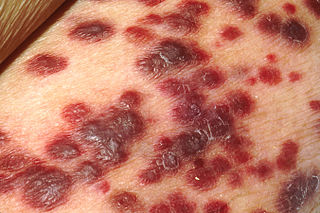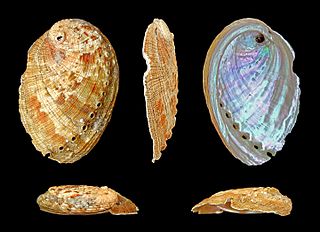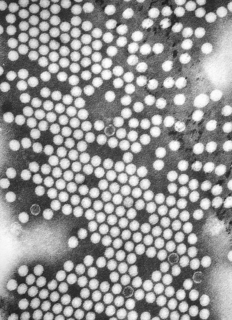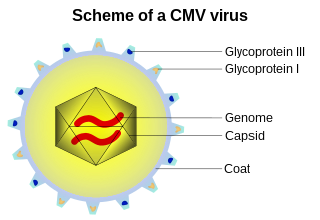
Cytomegalovirus (CMV) is a genus of viruses in the order Herpesvirales, in the family Herpesviridae, in the subfamily Betaherpesvirinae. Humans and monkeys serve as natural hosts. There are currently eight species in this genus including the type species, Human betaherpesvirus 5, which is the species that infects humans. Diseases associated with HHV-5 include mononucleosis, and pneumonia. In the medical literature, most mentions of CMV without further specification refer implicitly to human CMV. Human CMV is the most studied of all cytomegaloviruses.
Roseolovirus is a genus of viruses in the order Herpesvirales, in the family Herpesviridae, in the subfamily Betaherpesvirinae. Humans serve as natural hosts. There are currently three species in this genus including the type species Human betaherpesvirus 6A. Diseases associated with this genus include: HHV-6: sixth disease ; HHV-7: symptoms analog to the 'sixth disease'.
Rhadinovirus is a genus of viruses in the order Herpesvirales, in the family Herpesviridae, in the subfamily Gammaherpesvirinae. Human and mammals serve as natural hosts. There are currently nine species in this genus including the type species Saimiriine herpesvirus 2. Diseases associated with this genus include: Kaposi's sarcoma, primary effusion lymphoma and multicentric Castleman's disease, caused by Human herpesvirus 8 (HHV-8), also known as Kaposi's sarcoma-associated herpesvirus (KSHV). The term rhadino comes from the Latin fragile, referring to the tendency of the viral genome to break apart when it is isolated.

Kaposi's sarcoma-associated herpesvirus (KSHV) is the ninth known human herpesvirus; its formal name according to the International Committee on Taxonomy of Viruses (ICTV) is HHV-8. Like other herpesviruses, its informal name (KSHV) is used interchangeably with its more formal ICTV name. This virus causes Kaposi's sarcoma, a cancer commonly occurring in AIDS patients, as well as primary effusion lymphoma, HHV-8-associated multicentric Castleman's disease and KSHV inflammatory cytokine syndrome. It is one of seven currently known human cancer viruses, or oncoviruses.
White spot syndrome virus (WSSV) is the lone virus of the genus Whispovirus, which is the only genus in the family Nimaviridae. It is responsible for causing white spot syndrome in a wide range of crustacean hosts. White spot syndrome (WSS) is a viral infection of penaeid shrimp. The disease is highly lethal and contagious, killing shrimp quickly. Outbreaks of this disease have wiped out the entire populations of many shrimp farms within a few days, in places throughout the world.
Alphaherpesvirinae is a subfamily of Herpesviridae, primarily distinguished by reproducing more quickly than other subfamilies of Herpesviridae. In animal virology the most important herpesviruses belong to the Alphaherpesvirinae. Pseudorabies virus is the causative agent of Aujeszky's disease in pigs and bovine herpesvirus 1 is the causative agent of bovine infectious rhinotracheitis and pustular vulvovaginitis. Mammals serve as natural hosts. There are currently 37 species in this subfamily, divided among 5 genera. Diseases associated with this subfamily include: HHV-1 and HHV-2: skin vesicles or mucosal ulcers, rarely encephalitis and meningitis, HHV-3: chickenpox (varicella) and shingles, gaHV-2: Marek's disease.

Human herpesvirus 6 (HHV-6) is the common collective name for Human betaherpesvirus 6A (HHV-6A) and Human betaherpesvirus 6B (HHV-6B). These closely related viruses are two of the nine herpesviruses known to have humans as their primary host.

Herpesviridae is a large family of DNA viruses that cause infections and certain diseases in animals, including humans. The members of this family are also known as herpesviruses. The family name is derived from the Greek word herpein, referring to spreading cutaneous lesions, usually involving blisters, seen in flares of herpes simplex 1, herpes simplex 2 and herpes zoster (shingles). In 1971, the International Committee on the Taxonomy of Viruses (ICTV) established Herpesvirus as a genus with 23 viruses among four groups. Latent, recurring infections are typical of this group of viruses, though the family name does not refer to latency. Herpesviridae can cause latent or lytic infections.
Bacteriophage T7 is a bacteriophage, a virus that infects susceptible bacterial cells, that is composed of DNA and infects most strains of Escherichia coli. Bacteriophage T7 has a lytic life cycle and several properties that make it an ideal phage for experimentation.

Herpes simplex virus1 and 2, also known by their taxonomical names Human alphaherpesvirus 1 and Human alphaherpesvirus 2, are two members of the human Herpesviridae family, a set of viruses that produce viral infections in the majority of humans. Both HSV-1 and HSV-2 are common and contagious. They can be spread when an infected person begins shedding the virus. About 67% of the world population under the age of 50 has HSV-1. In the United States more than one-in-six people have HSV-2. Although it can be transmitted through any intimate contact, it is one of the most common sexually transmitted infections.

Gammaherpesvirinae is a subfamily of viruses in the order Herpesvirales, in the family Herpesviridae. Viruses in Gammaherpesvirinae are distinguished by reproducing at a more variable rate than other subfamilies of Herpesviridae. Mammals serve as natural hosts. There are currently 32 species in this subfamily, divided among 4 genera. Diseases associated with this subfamily include: HHV-4: infectious mononucleosis. HHV-8: kaposi's sarcoma.
Macacine alphaherpesvirus 1, Herpesvirus simiae, or Herpes virus B) is the Simplexvirus infecting macaque monkeys. Macacine alphaherpesvirus 1 is an alphaherpesvirus, which consists of a subset of herpes viruses that travel within hosts using the peripheral nerves. As such, this neurotropic virus is not found in the blood.
Iridoviridae is a family of viruses with double-stranded DNA genomes. Amphibia, fish, invertebrates, lepidoptera, and orthoptera insects serve as natural hosts. There are currently 12 species in this family, divided among two subfamilies and 5 genera.

Lymphocryptovirus is a genus of viruses in the order Herpesvirales, in the family Herpesviridae, in the subfamily Gammaherpesvirinae. This genus includes the human-infecting Human gammaherpesvirus 4, as well as viruses that infect both Old World monkeys and New World monkeys. Other names for the Lymphocryptovirus genus include Lymphocryptoviridae and gamma-1 herpesviruses. There are currently eight species in this genus including the type species Human gammaherpesvirus 4. Diseases associated with this genus include: mononucleosis, Burkitt's lymphoma, and nasopharyngeal carcinoma.
Cyprinid herpesvirus 3 is a species of virus causing a viral disease that is very contagious to the common carp Cyprinus carpio. It is most commonly found in ornamental koi, which are often used in outdoor ponds or as feeder stock. The first case of KHV was reported in 1998, but not confirmed until later in 1999.

The Herpesvirales is an order of dsDNA viruses with animal hosts, characterised by a common morphology consisting of an icosahedral capsid enclosed in a glycoprotein-containing lipid envelope. Common infections in humans caused by members of this order include cold sores, genital herpes, chickenpox, shingles, and glandular fever.
Simone Warner is an Australian scientist, a microbiology researcher. She currently leads the Microbiology group within the Victorian Department of Environment and Primary Industries, based at the Centre for AgriBiosciences in Bundoora, situated on the La Trobe University campus.
Aurivirus is a genus of viruses in the order Herpesvirales, in the family Malacoherpesviridae. Haliotidae molluscs serve as natural hosts. There is currently only one species in this genus: the type species Haliotid herpesvirus 1. Diseases associated with this genus include: acute ganglioneuritis.
Ranid herpesvirus 1 (RaHV-1), also known as the Lucké tumor herpesvirus (LTHV), is a double-stranded DNA virus within the order Herpesvirales. The virus was initially observed within renal tumors in 1934 by Baldwin Lucké, and more recently has become identifiable through the use of PCR in samples isolated from frog tumors. RaHV-1 causes renal tumors within the northern leopard frog, Rana pipiens. The virus has not yet been isolated in vitro within cell lines, meaning that while its existence and symptoms are fairly evident, its methods of transmission, cell infection, and reproduction are largely unknown.












